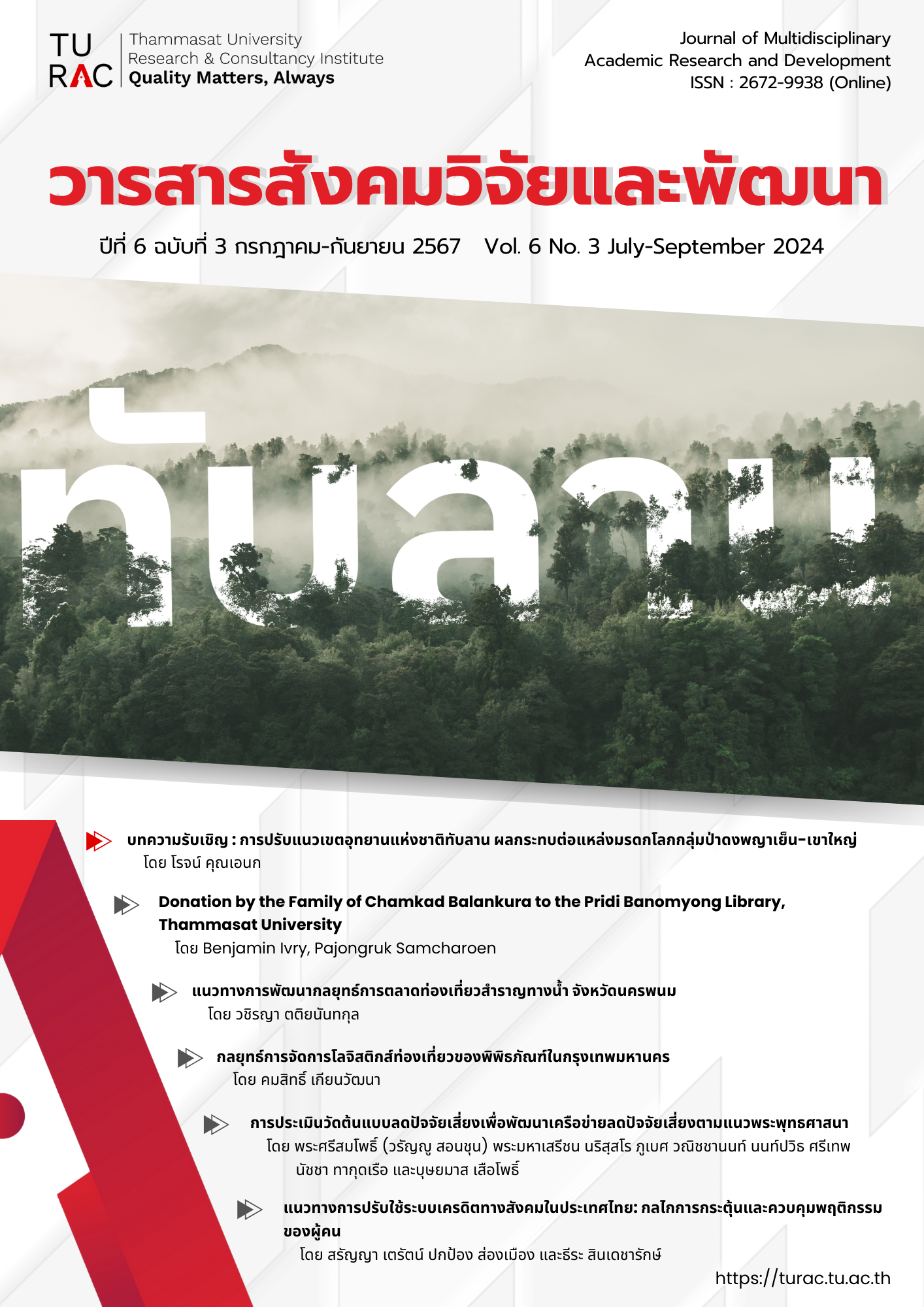Assessment of Prototype Temples for Reducing Risk Factors to Develop a Network to Reduce Risk Factors in Accordance with the Buddhist Religion
Keywords:
Risk reduction networks in accordance with Buddhist principles, Prototype temples to reduce risk factors, Health risk factors, BovornAbstract
During the COVID-19 pandemic, Buddhist institutions have played a more prominent role in role adjustment, underscoring their potential to support people's growth and wellbeing. Temples, being essential components of Buddhist establishments, have had a pivotal role in this endeavor. This article aims to better understand the establishment and advancement of model temple networks that reduce risk factors at the provincial level, utilizing the “Bovorn” principle, employing a mixed-methods approach. In the quantitative research, data were gathered from 160 model temples that were involved in the assessment of risk factors reduction. Meanwhile, the qualitative research consists of conducting interviews with key informants, such as monastic leaders and monks who were actively engaged in coordinating risk-reduction initiatives within the temples. The total number of participants involved in these interviews was 24.
The study revealed that the majority of model temples implemented risk factor reduction strategies based on four primary performance indicators: The key factors for consideration include: 1) Strict adherence to the Buddhist code of monastic discipline, resolutions set by the Sangha Supreme Council, and state laws; 2) Policies implemented by the temples; 3) Organization of activities aimed at reducing risk factors; and 4) Collaborating with partner networks. The Sangha Supreme Council and legal institutions establish standards and practices to monitor and guide these actions, ensuring public health welfare. As a result, legal institutions have converted temples into regulated environments, displacing risks to health such as smoking, alcohol consumption, and gambling. These risk factors have been substituted with socially oriented activities that incorporate Buddhist principles, thereby enhancing the community's quality of life. The effectiveness of these initiatives relies significantly on a robust social network, which is an essential component in extending the risk-reduction temple model to other communities in the future.
References
ชลวิทย์ เจียรจิตต์, ชัยวัชร พรหมจิตติพงศ์ และธันนิกานต์ สูญสิ้นภัย. (2565). สู่สังคมสุขภาวะ: การพัฒนาเครือข่ายสุขภาวะขององค์กรพระพุทธศาสนาจังหวัดนครนายกและสระแก้ว. วารสารศิลปศาสตร์ มหาวิทยาลัยอุบลราชธานี. 18(2), 132-156.
ชลวิทย์ เจียรจิตต์, และสายชล ปัญญชิต. (2565). สังฆะ สังคม สุขภาวะ: บทวิเคราะห์ทางสังคมวิทยากับการสร้างสุขภาวะวิถีพุทธขององค์กรพระพุทธศาสนา. พิมพ์ครั้งที่ 2. พระนครศรีอยุธยา: สถาบันวิจัยพุทธศาสตร์ มหาวิทยาลัยมหาจุฬาลงกรณราชวิทยาลัย.
ชลวิทย์ เจียรจิตต์. (2566). ชุมชน 5.0. พิมพ์ครั้งที่ 2. นนทบุรี: นิติธรรมการพิมพ์.
ธานี สุวรรณประทีป, วุฒินันท์ กันทะเตียน และพงษ์พัฒน์ ใหม่จันทร์ดี. (2565). รูปแบบการเสริมสร้างสุขภาวะวิถีพุทธเพื่อป้องกันการดื่มแอลกอฮอล์และการสูบบุหรี่ในเยาวชนไทย. วารสารพุทธศาสน์ศึกษา จุฬาลงกรณ์มหาวิทยาลัย. 29(2), 54-74.
พระมหาสุทิตย์ อาภากโร, ณัทธีร์ ศรีดี, พระครูพิพิธสุตาทร (บุญช่วย), จักรกริช สังขมณี, พระราชวรมุนี (พล), และวันชัย พลเมืองดี. (2556). การพัฒนาระบบการบริหารจัดการและการสร้างเครือข่ายองค์กรพระพุทธศาสนาในประเทศไทย. พระนครศรีอยุธยา: โครงการวิจัยการพัฒนาระบบการบริหารจัดการและการสร้างเครือข่ายองค์กรพระพุทธศาสนาในประเทศไทย สถาบันวิจัยพุทธศาสตร์ มหาวิทยาลัยมหาจุฬาลงกรณราชวิทยาลัย.
ศูนย์วิจัยกสิกรไทย. (2563). กระแสรักสุขภาพจากโควิด สร้างโอกาสธุรกิจ SME. สืบค้นจาก https://www. kasikornbank.com/th/business/sme/ksmeknowledge/article/ksmeanalysis/pages/healthtrend_sme.aspx.
สถาบันวิจัยประชากรและสังคม มหาวิทยาลัยมหิดล. (2566). รายงานสุขภาพคนไทย พ.ศ. 2566: คำ สัญญาของไทยใน “คอป” (COP: Conference of Parties) กับการรับมือ “โลกรวน”. นครปฐม: สถาบันวิจัยประชากรและสังคม มหาวิทยาลัยมหิดล ร่วมกับ สำนักงานกองทุนสนับสนุนการสร้างเสริมสุขภาพ.
สายชล ปัญญชิต. (2565). พฤติกรรมการป้องกันปัจจัยเสี่ยงทางสุขภาพของสามเณรวัยใสในภาคกลางและภาคเหนือของประเทศไทย. วารสารประชากรศาสตร์. 38(2), 28-49.
สิริทรัพย์ สีหะวงษ์, ปิยณัฐ สร้อยคำ, วิภาพรรณ ตระกูลสันติรัตน์, และเกริก พิสัยพันธ์. (2567). การมีส่วนร่วมของชุมชนในการพัฒนาวัดควบคุมการบริโภคบุหรี่และแอลกอฮอล์ในจังหวัดอุบลราชธานี. วารสารวิทยาศาสตร์สุขภาพและสุขภาวะ. 28(1), 63-76.
อภิญญา เฟื่องฟูสกุล. (2553). ศาสนา. ใน ภาควิชาสังคมวิทยาและมานุษยวิทยา คณะสังคมศาสตร์ มหาวิทยาลัยเชียงใหม่ (บ.ก.), แนวความคิดพื้นฐานทางสังคมและวัฒนธรรม (หน้า 79-92). เชียงใหม่: ภาควิชาสังคมวิทยาและมานุษยวิทยา คณะสังคมศาสตร์ มหาวิทยาลัยเชียงใหม่.
อรัญญา ศิริผล. (2562). ปฏิบัติการศาสนา ทุนจิตวิญญาณ กับการเมืองวัฒนธรรมจีนในชายแดนไทยภาคเหนือ. เชียงใหม่: ศูนย์วิจัยและบริการวิชาการ คณะสังคมศาสตร์ มหาวิทยาลัยเชียงใหม่.
Burrows, R., Nettleton, S., & Bunton, R. (1995). Sociology and health promotion: health, risk and consumption under late modernism. In Robin Bunton, Roger Burrows, & Sarah Nettleton (eds.), The sociology of health promotion: Critical analyses of consumption, lifestyle and risk. (pp. 1-10). London: Routledge.
Famer, P. (1992). AIDS and Accusation: Haiti and the Geography of Blame. California: University of California Press.
Flecha, R. (2020). Contributions from Social Theory to Sustainability for All. Sustainability. 12(23), 9949. Retrieved from https://doi.org/10.3390/su12239949.
Downloads
Published
How to Cite
Issue
Section
License
Copyright (c) 2024 Journal of Multidisciplinary Academic Research and Development (JMARD)

This work is licensed under a Creative Commons Attribution-NonCommercial-NoDerivatives 4.0 International License.



